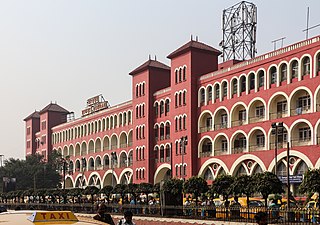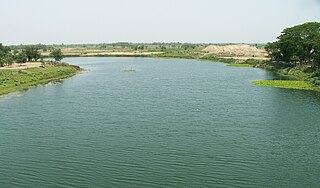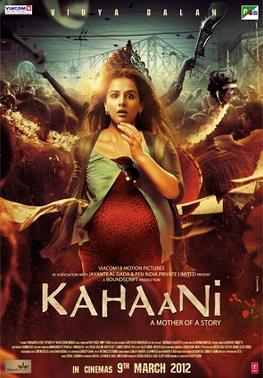
Howrah is a city in the Indian state of West Bengal. Howrah is located on the western bank of the Hooghly River opposite its twin city of Kolkata. Administratively it lies within Howrah district, and is the headquarters of the Howrah Sadar subdivision. It is the third most populated city in West Bengal after Kolkata and Asansol. Howrah is an important transportation hub and gateway to Kolkata and West Bengal via Howrah railway station and Howrah Bridge.
Events in the year 1982 in the Republic of India.

The Howrah Bridge is a balanced steel bridge over the Hooghly River in West Bengal, India. Commissioned in 1943, the bridge was originally named the New Howrah Bridge, because it replaced a pontoon bridge at the same location linking the cities of Howrah and Kolkata, which are located at the opposite banks of each other. On 14 June 1965, it was renamed Rabindra Setu after the Bengali poet Rabindranath Tagore, who was the first Indian and Asian Nobel laureate. It is still popularly known as the Howrah Bridge.

Howrah railway station is a railway station located in the city of Howrah, West Bengal, India. It is the largest and busiest railway complex in India as well as one of the busiest and largest train stations in the world. It is also the oldest surviving railway station complex in India. Howrah is one of six intercity train stations serving the Kolkata metropolitan area, the others being Sealdah, Dankuni, Santragachi, Shalimar and Kolkata railway station.

Sealdah Railway Station is one of India's major railway terminals serving the city of Kolkata. The other main railway stations in the Kolkata metropolitan area are Howrah, Shalimar, Kolkata and Santragachi. Over 1.2 million passengers use the station daily. It is an important suburban rail terminal. Kolkata Metro Line 2 passes through Sealdah with the new underground Sealdah metro station.

Pamban Bridge is a railway bridge that connects the town of Mandapam in mainland India with Rameswaram on Pamban Island. Opened on 24 February 1914, it was India's first sea bridge, and was the longest sea bridge in India until the opening of the Bandra-Worli Sea Link in 2010. The rail bridge is, for the most part, a conventional bridge resting on concrete piers but has a double-leaf bascule section midway, which can be raised to let ships and barges pass through. Until 1988, the Pamban bridge was the only surface transport that connected Tamil Nadu's island of Rameswaram to the mainland India. On 23 December 2022, the bascule of this bridge was damaged due to extreme corrosion and so the sensors gave continuous warning signal which suspended transportation on the bridge permanently. The last train which officially ran on this bridge was Train no. 07695 Secunderabad - Rameswaram Special Express, which had completed its commercial journey the previous day. In February 2023, the Southern Railway announced that the train traffic to Rameshwaram through Pamban bridge had been completely stopped and would be restored through the new Pamban bridge after its completion.

Kasba is an upscale and standard locality of South Kolkata, in Kolkata district, West Bengal, India. It is situated in the southern part of the city encircled by the Sealdah South section of the Eastern Railways to the west, Dhakuria and Haltu to the south, the Eastern Metropolitan Bypass to the east and the locality of Tiljala to the north.
Sombhu Mitra was an Indian film and stage actor, director, playwright, reciter and an Indian theatre personality, known especially for his involvement in Bengali theatre, where he is considered a pioneer. He remained associated with the Indian People's Theatre Association (IPTA) for a few years before founding the Bohurupee theatre group in Kolkata in 1948. He is most noted for films like Dharti Ke Lal (1946), Jagte Raho (1956), and his production of Rakta Karabi based on Rabindranath Tagore's play in 1954 and Chand Baniker Pala, his most noted play as a playwright.

Rashbehari Avenue is one of the most prestigious and important east–west avenues of Kolkata, India. A major portion of this road is often commonly referred to as Gariahat, the prime shopping and aristocratic residential neighbourhood of south Kolkata. Rashbehari Avenue falls in the posh residential neighbourhood of Ballygunge. The road is named after Sir Rash Behari Ghosh who was an Indian politician, lawyer, social worker and philanthropist.

Jalangi River, is a branch of the Ganges river in Murshidabad and Nadia districts in the Indian state of West Bengal. It flows into the Bhagirathi river and strengthens its lower channel, the Hooghly.
The Bijon Setu massacre was the killing and burning of 16 sadhus and a sadhvi of Ananda Marga, at Bijon Setu, West Bengal, India, on 30 April 1982. Although the attacks were carried out in broad daylight, no arrests were ever made. After repeated calls for a formal judicial investigation, a single-member judicial commission was set up in 2012 to investigate the killings.

Kahaani is a 2012 Indian Hindi-language thriller film co-written, co-produced, and directed by Sujoy Ghosh. It stars Vidya Balan as Vidya Bagchi, a pregnant woman looking for her missing husband in Kolkata during the festival of Durga Puja, assisted by Assist Sub-Inspector Satyoki "Rana" Sinha and Inspector General A. Khan.

Samaresh Basu was an Indian writer in modern Bengali literature, known for his versatility and vast range of themes. He wrote under the pen name Kalkut. Basu was awarded the 1980 Sahitya Akademi Award in Bengali, by Sahitya Akademi, India's National Academy of Letters, for his novel, Shamba. He won the 1983 Filmfare Awards for Best Story for Namkeen.

The Digha–Sonpur bridge or J. P. Setu is a rail-cum-road steel truss bridge across river Ganga, connecting Digha Ghat in Patna and Pahleja Ghat in Sonpur. It is named after Indian independence activist Jayaprakash Narayan. It provides easy roadway and railway link between north and south Bihar.

Rabin Deb is an Indian politician. He is currently a member of the Central Committee of the Communist Party of India (Marxist) [abbreviated CPI(M)] and was member of the Legislative Assembly from Ballygunge constituency (1992–2006), where he was Chief Government Whip (2003-2006) of the Government of West Bengal. He helped Central Bureau of Investigation in connection with the Saradha scam by sharing his point of view.

Bharpura Pahlejaghat Junction, station code PHLG, is a railway station in Sonpur division of East Central Railway. Bharpura Pahlejaghat Junction is located in Sonpur city in Saran district in the Indian state of Bihar. It is located on the north end of Digha–Sonpur rail–road bridge, while Patliputra is on the south end of the bridge. Pahleja Station is 3.81 km from Sonpur and 11.46 km from Patliputra. It is connected to Sonpur on its east side and Parmanandpur station on its west side. In June 2017, a 20 kW roof top hybrid solar plant with 20% storage facility installed and commissioned at Pahaleja Ghat railway station.
Nandy Bagan or Nandi Bagan is a neighbourhood of South Kolkata in the Indian city of Kolkata in West Bengal. It is a residential area surrounded with Kasba, Haltu, Garfa, Jadavpur, Babu Bagan, Dhakuria, Naskarpara, Shahid Nagar, Bosepukur and Selimpur. It is traditionally an upper-middle-class neighbourhood, situated around the Nandi Bagan community playground. However, with the newly constructed Prince Anwar Shah Road connector with the Eastern Metropolitan Bypass, property prices have increased in the area. The area is covered by the Garfa Police Station of the Kolkata Police Force. The Haltu Post Office serves the area.

Belanagar railway station is a Kolkata Suburban Railway station on the Howrah–Bardhaman chord line operated by Eastern Railway zone of Indian Railways. It is situated at Bally Jagachha Block, Belanagar in Howrah district in the Indian state of West Bengal. Number of EMU trains stop at Belanagar railway station. This railway station is named after Bela Mitra, a freedom fighter and social activist. This was the first Railway station in India named after any Indian woman.
Sachin Sen was an Indian politician belonging to the Communist Party of India (Marxist). He was a member of the West Bengal Legislative Assembly from Ballygunge constituency (1977–1992), and served as Chief Government Whip from 1989 to 1991.














